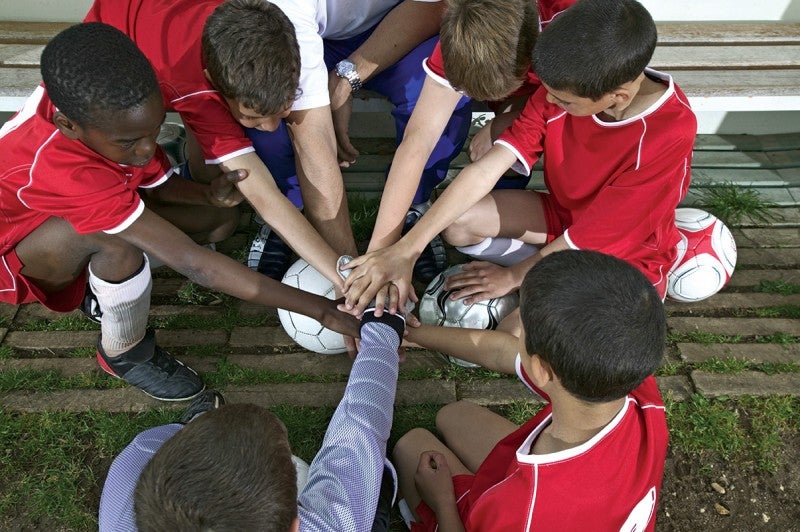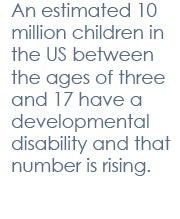
The USA Bobsled and Skeleton Federation has partnered with the Aspen Institute Sports and Society Program’s Project Play initiative to explore ways to get and keep children active through sports. Below, the USA Bobsled Federation CEO Darrin Steele reflects on what he’s learned about the power of sports in raising a child with a developmental disability.
Some people find their calling working with kids with developmental disabilities. Other people find themselves in that world unexpectedly. For parents like me, it’s the latter.
The learning curve is steep, and to call the education an emotional roller coaster would be a gross understatement. I have to confess that when we got the diagnosis that my son has autism, I assumed there was an established path we would plug him into. The comfort we got from finally having a diagnosis was eclipsed by the realization that America was ill-prepared to handle the fastest growing developmental disability in the nation. We quickly realized that he wasn’t entering a path; he was exiting one.

My son loves physical activity and he has natural athleticism. He reminded me of me when I was young, and I was happy his motor skills were very good. I was troubled by the therapy he got, which took a lot of time and involved a lot of sitting. He didn’t do well. He was immersed in an inclusive classroom, which we supported and still do. He stays in the classroom as much as possible, but goes to the special needs room when necessary. He’s in a great school and we are lucky to have him there.
Even though this might be as good as it gets, the reality is that the system wasn’t built for kids like him and he really doesn’t belong there. All too often, we are reminded that kids like my son don’t really belong anywhere. He makes too much noise, he doesn’t follow directions, he can’t keep up with his peers, and he gets in the way.
This is where sport comes in. I experienced the power of sport as a child and quickly figured out that my social stock rose due to my achievements in sports. That was great news for a shy kid like me. Sport has the unique ability to not only provide an experiential education that serves real life, but it is one of the only possible experiences that rewards heart, drive, and teamwork.
Sport offers something else that no other experience does: the concept of the “personal best.” There is a universal understanding in sport that a personal best is something special because in sport, you compete against yourself. Sure, there are other competitors, but they are there to help bring out the best in you. Sport allows us to define success at an individual level.
These kids with disabilities are reminded of their weaknesses on a daily basis. While most kids gravitate toward their areas of strength, the Individualized Education Program process for kids with special needs is primarily focused on areas of weakness. What would happen if these same kids were introduced to sport? Fortunately, we don’t have to guess. I had the pleasure of studying one of the few sports organizations on the country that provides sports programs for kids with developmental disabilities. Sports Plus, in Montgomery County, Maryland, allowed me to observe the programs and talk with the parents of participants.
Sports Plus quickly realized that having positive coaches — who had fun with the participants while demanding incremental sport improvement — was an absolute requirement for success. The kids took pride in their improvements and experienced social gains from both engaging the coaches and feeling a sense of belonging with their peers. More than 95 percent of participants are repeat customers.
I have seen the impact of physical activity on my son Darrin Khan as well, although he’s never participated in organized sports. This is a kid who has been on the move since he came out of the womb. He is a lot like I was as a child and we both fit the definition for ADHD. Dr. John Ratey, professor of psychiatry at Harvard Medical School, has studied the outcomes of exercise on those with ADHD and regularly prescribes exercise rather than drugs to his ADHD patients. Not only does physical activity make my son happy while he’s doing it, but he’s much calmer and less inclined to have meltdowns after.
I have yet to find a sports program that can handle him. Although he has a high level of athletic ability, mainstream sports require too much cognitive application and team sports require too much communication and social interaction. For now, he swims, climbs, and dances for fun. I recently took him to a martial arts class because I trusted the coach and the coach knows my son. He certainly enjoyed the experience, but he didn’t understand why he was punching and kicking the heavy bags and he doesn’t like to stand in line.
Above, watch Steele’s son in his first Mixed Martial Arts (MMA) class.
Kids like my son need much more one-on-one instruction at the beginning and they will learn faster if they are shown what to do rather than told. The other kids will accept these kids, strange behavior and all, if the coach sets the tone. Those aren’t major modifications and they could make all the difference.
I have seen some resistance to creating programs specific to kids with developmental disabilities. I certainly think we should include them in mainstream programs where, when, and if it makes sense. Sports are fun when the challenge is reasonable and the athletes and teams are evenly matched. Yes, there should be winners and losers because there are important life lessons to be learned. If evenly matched means that teams are exclusively made up of kids with developmental disabilities, then we should encourage it. If we can include them into mainstream programs with some adaptations to their training, then we should most definitely do that.
The thing that we should remember about all sports is that we are ultimately competing against ourselves. It’s much easier to define success in general terms that we can all understand, but all participants should celebrate the idea of personal struggles and personal bests.
A few weeks ago, I was able to see a video that my son’s 3rd grade teacher took. She does a great job of including music and dance in class throughout the day. This is a regular inclusive classroom and we worry about how he’s doing when we’re not around. This video showed him leading the class in a dance to the song Ghostbusters. This is something he’s good at and his teacher recognized the opportunity to play to his strengths in front of his peers. It’s something that kids like him don’t get to experience often and it brought tears to my eyes to see it. That is what sports can do if we get it right.
This school is an exception, unfortunately, but the experience above is one of the reasons he has kids saying, “Hi” to him constantly and why he feels like he belongs.
An estimated 10 million children in the United States between the ages of three and 17 have a developmental disability and that number is rising. These children often have physical, emotional, social, and cognitive challenges that result in a lower health-related quality of life (HRQoL) and much lower sport participation rates than neurologically typical children. Youth sports have proven to increase the HRQoL in children.
Often-overlooked aspects of inclusion are the benefits to the children without disabilities. These children have been found to not only increase their social skills when in the same classroom as diverse students, but also see improvements in leadership, self-esteem, and confidence.
So, why make room for kids with developmental disabilities? Because every kid deserves to feel like they belong somewhere. Sports are uniquely capable of offering this to kids who have more challenges than solutions, more questions than answers, and more places where they don’t belong than those where they do. In short, because everyone wins.
RELATED CONTENT:

